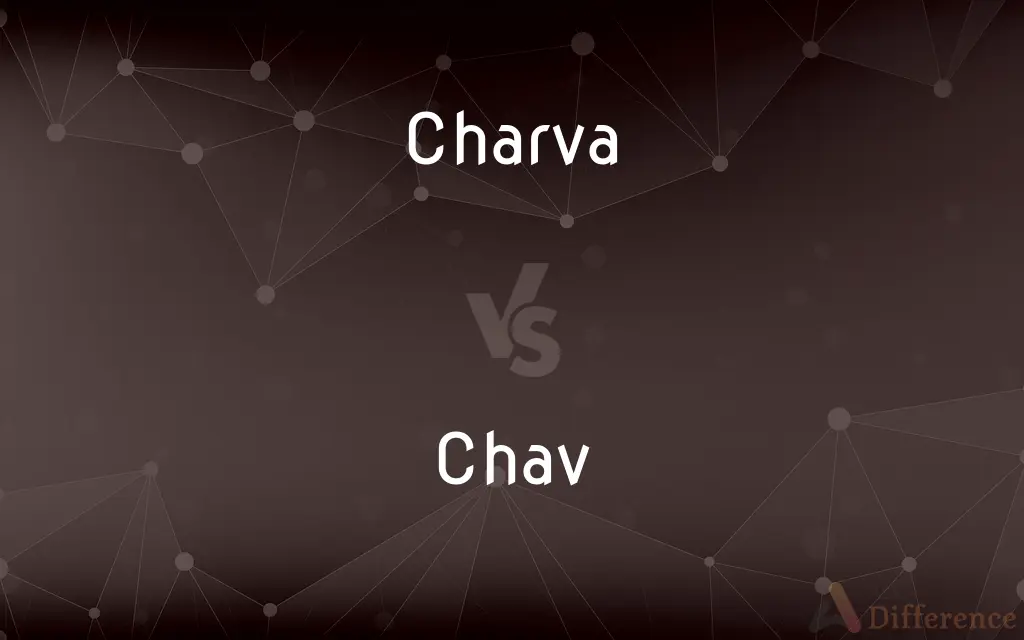Charva vs. Chav — What's the Difference?
By Maham Liaqat & Fiza Rafique — Updated on April 3, 2024
Charva refers to a subcultural group in the North East of England, characterized by specific fashion choices and behaviors, whereas chav is used in wider UK to describe a similar subculture with a focus on flashy attire and perceived anti-social behavior.

Difference Between Charva and Chav
Table of Contents
ADVERTISEMENT
Key Differences
Charva is a term specific to the North East of England, identifying individuals who are part of a subculture known for wearing designer sportswear, engaging in rowdy behavior, and often congregating in public spaces. On the other hand, chav is a broader term used across the UK to denote a somewhat similar group, but with a stronger emphasis on their flashy, branded clothing and accessories, and often associated with derogatory connotations related to their social status and behavior.
While both terms refer to subcultures with a distinct style of dress and behavior, charva tends to be used more regionally and without as strong negative connotations as chav. In contrast, the term chav has been widely criticized for perpetuating classist stereotypes and is often used pejoratively to mock or demean individuals for their taste in fashion, manner of speech, and public demeanor.
Charvas are particularly noted for their loyalty to specific brands and types of sportswear, which they wear as a badge of identity. This contrasts with chavs, who, while also brand-conscious, are often portrayed in media and popular culture as favoring ostentatious, flashy, and sometimes fake designer goods to display wealth or status that may not necessarily reflect their actual socio-economic position.
The perception and social implications of being labeled as a charva or chav vary significantly. In the North East, being a charva might simply signify belonging to a local youth culture. However, being called a chav elsewhere in the UK can carry more profound social stigma, implying not just a fashion choice but also a judgment on one's behavior, values, and place in society.
Despite these differences, both terms have sparked discussion about social class, identity, and youth culture in the UK. They highlight how clothing and subcultural affiliations can be used to both express belonging and reinforce social divides, although the impact and perception of these labels differ depending on regional contexts and societal attitudes.
ADVERTISEMENT
Comparison Chart
Region
North East of England
Widespread across the UK
Connotations
Less negative, regional identity
Often pejorative, with strong classist overtones
Fashion
Designer sportswear, specific brands
Flashy, branded clothing and accessories
Behavior
Rowdy, congregating in public spaces
Perceived anti-social behavior
Social Perception
Part of local youth culture
Associated with lower-class stereotypes
Compare with Definitions
Charva
Identifies with specific fashion and music.
That charva was wearing the latest Adidas trainers.
Chav
Often carries negative stereotypes about behavior and social status.
That movie character is such a stereotypical chav.
Charva
Associated with congregating in public places.
The shopping center is a popular hangout for charvas on weekends.
Chav
Reflects broader societal attitudes towards youth and class.
The debate about the term chav highlights UK's issues with classism.
Charva
A member of a North Eastern English subculture known for wearing sportswear.
You could see a group of charvas hanging out at the metro station.
Chav
Seen by some as derogatory and classist.
Using chav pejoratively can reinforce class divides.
Charva
Often seen as part of a local youth culture.
Charvas often spend their evenings at local parks.
Chav
A term used across the UK to describe individuals with a flashy style.
The media often portrays chavs wearing tracksuits and gold chains.
Charva
Not necessarily pejorative in the North East.
He identifies as a charva and is proud of it.
Chav
Associated with the wearing of branded or fake designer goods.
She was criticized for her chav-like choice of accessories.
Charva
Unruly youth; disobedient child or teenager.
Chav
"Chav" (), also "charver" and "scally" in parts of England is a British pejorative term used to describe an anti-social lower-class youth dressed in sportswear. "Chavette" is a related term referring to female chavs, and the adjectives "chavvy", "chavvish", and "chavtastic" are used to describe things associated with chavs, such as fashion, slang, etc.
Charva
A chav.
Chav
Used as a disparaging term for a poor or uneducated young person, especially one who behaves in a brash or vulgar manner and wears ostentatious clothing and jewelry.
Charva
Friend; mate.
Chav
A working-class youth, especially one associated with aggression, poor education, and a perceived "common" taste in clothing and lifestyle.
Common Curiosities
What is a charva?
A charva is an individual associated with a specific subculture in the North East of England, characterized by certain fashion choices and behaviors.
How do fashion choices define a charva or chav?
Both groups are defined by their preference for certain brands of sportswear and accessories, though chavs are particularly noted for flashy, sometimes faux designer items.
Is there a particular age group associated with charvas and chavs?
Both terms are primarily associated with youth and young adults but can be applied to individuals outside these age groups based on behavior and fashion.
What does chav mean?
Chav is a term used in the UK to describe a subculture known for flashy attire and behaviors often viewed negatively.
Why is the term chav considered offensive?
Chav is often considered offensive because it can carry classist connotations, used to demean people based on their social status and lifestyle choices.
How has the perception of charvas and chavs changed over time?
Media portrayal and societal attitudes have evolved, sometimes reinforcing stereotypes, while at other times challenging them or offering more nuanced views.
Do charvas and chavs only exist in urban areas?
While more visible in urban settings, the characteristics associated with charvas and chavs can be found in various environments.
How do media representations affect the image of charvas and chavs?
Media often amplifies stereotypes, affecting public perception and potentially contributing to social stigma.
Can the fashion of charvas and chavs be considered a form of rebellion?
For some, adopting these styles can be a form of cultural or social rebellion, expressing resistance to mainstream norms and values.
Are the terms charva and chav interchangeable?
While they describe similar subcultures, they are not entirely interchangeable due to regional differences and the specific connotations of each term.
Can someone be proud to be a charva or chav?
Yes, some individuals may embrace these labels as part of their identity, despite or because of the societal connotations.
What role does socioeconomic status play in the charva and chav identities?
Socioeconomic status is central, with the terms often used to highlight or mock perceived social and economic positions within society.
Are there similar subcultures outside the UK?
Yes, many countries have analogous youth subcultures that express identity through fashion, music, and behavior, though the specific characteristics and societal reactions vary.
How do regional attitudes towards charvas and chavs differ?
Attitudes can vary significantly, with some regions displaying more acceptance and others more likely to use these terms pejoratively.
What impact do charvas and chavs have on society?
They highlight issues of class, identity, and youth culture, stimulating debates on social inclusion, stereotyping, and the role of fashion in societal perceptions.
Share Your Discovery

Previous Comparison
Chuckle vs. Laugh
Next Comparison
Earth vs. GlobeAuthor Spotlight
Written by
Maham LiaqatCo-written by
Fiza RafiqueFiza Rafique is a skilled content writer at AskDifference.com, where she meticulously refines and enhances written pieces. Drawing from her vast editorial expertise, Fiza ensures clarity, accuracy, and precision in every article. Passionate about language, she continually seeks to elevate the quality of content for readers worldwide.














































